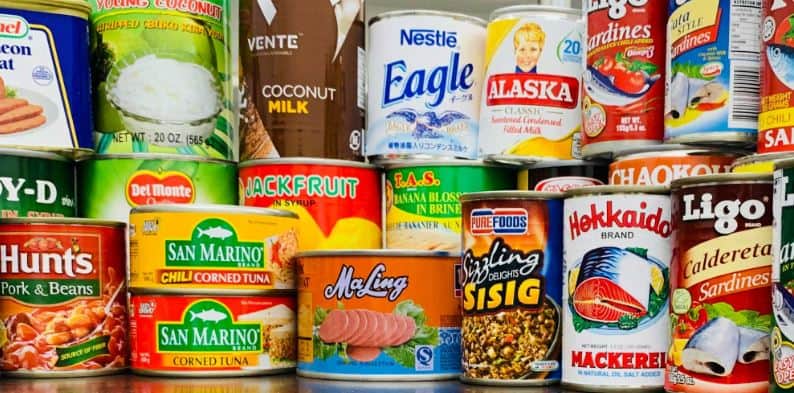
Last updated on May 13th, 2021 at 05:53 am
Every family in their pantry has its own stockpile of go – to food items, whether for fast meals or snacking at any time of day or night. Only look at this list of staples canned, bottled or packed: sardines, tuna, tuyo fillets (salt dried fish), sausages, luncheon meat, corned beef, instant noodles, milk, soda crackers, potato chips, etc. Let’s not mention the foods we have in the fridge, the fish and the prepared meals.
People may extend the list that would cover basically half of the store aisles with what is now readily available. But the Store shelves are almost bare with the current worldwide pandemic. Practicing some prudence and discipline in our consumption is best in expanding the limited resources we have over the long haul. After all, the best defense one can have against this unseen enemy is to maintain a safe body and to heed the advice of social distancing from the state.
During normal times it is commonly considered that packaged or canned foods are the enemy of the health conscious. Those are not standard days, however. These same canned goods may be our salvation, just as in World War II K-rations helped the frontliners.
Below are some useful tips about how to make safe and balanced meals out of these canned “unhealthy” products.
FIFO–The’ first-in, first-out’ rule will apply, especially to highly perishable fresh produce, fish, and meats. Check the expiry or “best by” dates, as for the canned and frozen products. The fact remains that a canned or bottled food item is still edible even it is past its expiry date. Not only at its highest flavour.
The advantages of canned products can not be adequately emphasised.
The fruits and vegetables used for canning are harvested at peak freshness, ensuring the maximum taste and quality of nutrients.
Canned foods can be just as nutritious as fresh and frozen foods as many nutrients are protected from canning. The canning cycle keeps the amount of nutrients, fat-soluble vitamins, calcium, fat and carbohydrates largely unchanged. The canning cycle guarantees a long shelf life of at least one to five years. This can be helpful for people who frequently throw away fresh produce because of the spoilage.
Combine processed food with that of “eating.” Although most processed meats and canned seafood are considered unhealthy, they are still a necessity in today’s kitchen, as they are simple to cook and convenient to produce. The trick is to feed them with some “living food,” that is to say fresh or canned vegetables and fruits. For nutritious and tasty one-dish meals, find the following: Corn beef hash–sauté with plenty of garlic, onion and tomatoes. Attach sliced cabbage, carrots and diced potatoes. In the end, the meat-to-veggies ratio will be 1:4.
The corned beef is for the vegetables to taste.
Lunch omelet–Slice meat into cubes and sauté with garlic and onion, add green and red bell pepper.
Salted fish fried rice–Inspired by the same name Chinese recipe, using bottled tuyo fillets to make this delicious year-round Lenten treat. It has all the ingredients of the all-time favorite breakfast fare from Pinoy, and more. Cook the eggs scrambled, then set aside. In the bottled tuyo, sauté the garlic using the oil, add some shredded fillets, add the cooked rice (make it brown for a healthier option) and mix well for one or two minutes. Just before serving, add the scrambled egg, lots of sliced tomatoes and lettuce while still moist. To complete the staple taste of Pinoy, sprinkle some spiced vinegar.
Sarsiado–called sofrito by the Spaniards, it’s essentially a tomato-based, all-around sauce that can spice up any meal. Add plenty of tomatoes and red bell pepper, add in garlic and onion. Voila, you sofrito! Try to pour it over any fried fish, meat and even hard-boiled egg that our mom used to serve us when we were young. Sofrito is the basis for paella making too. It can also be used to make sarsiadong isda / cardillo, sofrito fried fish, chicken broth, whisked egg (think egg-drop soup) and topped with lots of cilantro.
Vegan “Spam”-Tokwa / tofu or soybean curd is one of the staples in my list. Based on the firmness you choose, there is plenty to choose from in the supermarket chiller. For its durability I personally prefer the Chinese tofu brand Kem Kang (momen tofu): solid enough to maintain its shape while frying, but silky soft while bitten in. And as it comes in a sealed box it has an expiry date of one month. Cut it into 1/4 inch thick slices, fry in a little oil until light brown on both sides, then season with soy sauce and salabat powder (ginger brew), another staple in my pantry. To make a vegan chop suey, pancit canton, sukiyaki, or the Korean chapchae, using these tofu steaks.
The citizens of Davao City have a well-kept secret about canned sardines: “pantawid,” a dish that the budget-conscious segment of society uses to get by. Called udong, it’s a common noodle dish for students on a string budget, for employees, and even for home helpers. Udong are long, thin dried noodles, in appearance similar to Italian angel hair pasta, sold in small packs, but it is the cooking method that is strikingly standardized, according to everyone I asked in Davao. Water is boiled in a pot, pasta is placed in, copious amounts of chopped tomatoes and onions are added (no sautéing), then a can of local sardines is added.
These examples will surely make every meal exciting for the next days.
It’s time to be creative and making sure that the foods we eat are nutritious.
























